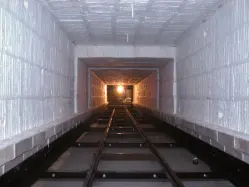Refractory Materials for Furnaces and Kilns
Heat is transmitted via conduction, convection, radiation or a combination of them. Heat always goes from hot to cold. Without insulation, heat will be radiated into the atmosphere. For example, a 400degF hot steel surface of 1 sqft will radiate approximately 400 W (1400 BTU/hr) into the atmosphere.
Refractories are non-metallic insulation materials that retains their strength at high temperature (above 1000 degF). Firebrick and ceramic fibers are the most common used refractory materials for high temperature furnaces and kilns. Refractories are mostly "dictated" by application parameters such as thermal process temperature profile and atmosphere. Oxides of alumina and silica are very common, while Zirconia, carbon and silicon carbide refractories are used for special applications.
Thermal conductivity “k” is expressed in how many BTU's of heat will travel through one square foot of material of one-inch thickness in one hour. (BTU/in/hr/sqft/degF) Every material has its own value. Insulation (“R”) is the reciprocal of thermal conductivity. It is not necessarily the case that thicker walled kilns and furnaces are more efficient. The walls of the kiln absorb heat, and if the firing is not of excessive duration, it is completed before the walls of the kiln have become heated to capacity. In this case, thicker walls serve no purpose and only slow cooling. But for extended firing (like in continuous furnaces), thick walls may be desirable.
Insulating bricks serve to increase the heat retention properties of the kiln. Bricks are graded according to “K-factors”; those sold as K-30, for example, will withstand 3000F without melting, bloating or deforming. The air trapped inside the firebrick is a fantastic insulator because of its thermal conductivity of 0.16 versus bricks which have 2.13 – 3.7 depending on mean temperature. Trapping the air in small chambers, like in foam, provides good insulation.
Convection is the most important mechanism of heat transfer in the lower temperature ranges. Once the heated surface become incandescent, these areas give off heat by radiation. It is therefore important that the insulation has a white and smooth surface because they radiate more efficiently.






